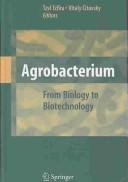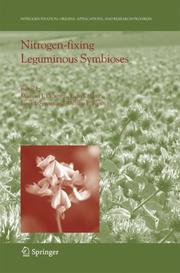| Listing 1 - 6 of 6 |
Sort by
|
Book
ISBN: 1608054616 9781608054619 9781608055524 Year: 2012 Publisher: Sharjah : Bentham Books,
Abstract | Keywords | Export | Availability | Bookmark
 Loading...
Loading...Choose an application
- Reference Manager
- EndNote
- RefWorks (Direct export to RefWorks)
The book explains background knowledge about rhizobia and follows this up with a broad perspective on rhizobial diversity, information on characteristics specific to each group of rhizobia, the relationship among rhizobial groups as well as genetic factors contributed to rhizobial diversity.
Rhizobiaceae. --- Molecular microbiology. --- Microorganisms --- Molecular bacteriology --- Microbiology --- Molecular biology --- Aerobic bacteria --- Gram-negative bacteria --- Nitrifying bacteria --- Molecular aspects
Book
ISBN: 3030032574 3030032566 Year: 2018 Publisher: Cham : Springer International Publishing : Imprint: Springer,
Abstract | Keywords | Export | Availability | Bookmark
 Loading...
Loading...Choose an application
- Reference Manager
- EndNote
- RefWorks (Direct export to RefWorks)
This volume reviews various facets of Agrobacterium biology, from modern aspects of taxonomy and bacterial ecology to pathogenesis, bacterial cell biology, plant and fungal transformation, natural transgenics, and biotechnology. Agrobacterium-mediated transformation is the most extensively utilized platform for generating transgenic plants, but modern biotechnology applications derive from more than 40 years of intensive basic scientific research. Many of the biological principles established by this research have served as models for other bacteria, including human and animal pathogens. Written by leading experts and highlighting recent advances, this volume serves both as an introduction to Agrobacterium biology for students as well as a more comprehensive text for research scientists.
Agrobacterium. --- Polymonas --- Rhizobiaceae --- Microbiology. --- Microbial genetics. --- Microbial genomics. --- Agriculture. --- Medical Microbiology. --- Microbial Genetics and Genomics. --- Farming --- Husbandry --- Industrial arts --- Life sciences --- Food supply --- Land use, Rural --- Genomics --- Microbial genetics --- Microorganisms --- Genetics --- Microbiology --- Microbial biology --- Biology --- Medical microbiology.
Book
ISBN: 3319649825 3319649817 Year: 2017 Publisher: Cham : Springer International Publishing : Imprint: Springer,
Abstract | Keywords | Export | Availability | Bookmark
 Loading...
Loading...Choose an application
- Reference Manager
- EndNote
- RefWorks (Direct export to RefWorks)
This book provides a valuable contribution to the field of agriculture microbiology and pooled research in the form of a compendium describing the benign functional role of Rhizobium spp., with biotechnological perspectives on maintaining agroecosystem sustainability. Topics include the occurrence and distribution of Rhizobium; the phenotypic and molecular characteristics of Rhizobium; the impact of Rhizobium on other microbial communities in the rhizosphere; the N2-fixation ability of Rhizobium; Rhizobium and abiotic/biotic stress; Rhizobium-mediated restoration of an ecosystem; and in silico analysis of rhizobia pool, and Biotechnological perspectives of Rhizobium.
Life sciences. --- Microbiology. --- Agriculture. --- Plant breeding. --- Mycology. --- Soil science. --- Soil conservation. --- Life Sciences. --- Applied Microbiology. --- Plant Breeding/Biotechnology. --- Eukaryotic Microbiology. --- Soil Science & Conservation. --- Rhizobium. --- Root nodule bacteria --- Rhizobiaceae --- Entomology. --- Conservation of soil --- Erosion control, Soil --- Soil erosion --- Soil erosion control --- Soils --- Agricultural conservation --- Soil management --- Insects --- Zoology --- Crops --- Agriculture --- Breeding --- Microbial biology --- Biology --- Microorganisms --- Farming --- Husbandry --- Industrial arts --- Life sciences --- Food supply --- Land use, Rural --- Control --- Prevention --- Conservation --- Pedology (Soil science) --- Earth sciences --- Botany --- Fungi --- Microbiology --- Fungal biology --- Fungology --- Fungus biology

ISBN: 1281141291 9786611141295 0387722904 0387722890 1441924736 Year: 2008 Publisher: New York : Springer,
Abstract | Keywords | Export | Availability | Bookmark
 Loading...
Loading...Choose an application
- Reference Manager
- EndNote
- RefWorks (Direct export to RefWorks)
Agrobacterium is the only cellular organism on Earth that is naturally capable of transferring genetic material between the kingdoms of life, from prokaryotes to eukaryotes. Studies have uncovered a wealth of information on the process of Agrobacterium-mediated genetic transformation and on the bacterial and host cell factors involved in the infection. Agrobacterium has been shown to genetically transform, under laboratory conditions a large number of plant species and numerous non-plant organisms, indicating the truly basic nature of the transformation process. It is therefore not surprising that Agrobacterium and the genetic transformation itself have also become the focus of numerous ethical and legal debates. ‘Agrobacterium’ is a comprehensive book on Agrobacterium research, including its history, application, basic biology discoveries, and effects on human society. Although the book largely focuses on providing a detailed review of virtually all molecular events of the genetic transformation process, it also provides coverage of ethical and legal issues relevant to the use of Agrobacterium as a "genetic transformation machine". The result is an all-inclusive text which readers—including scientists and students involved in plant genetic engineering—will find useful as a reference source for all major aspects of the Agrobacterium-mediated genetic transformation of plant and non-plant organisms. About the Editors: Dr. Tzvi Tzfira is an Assistant Professor in the Department of Molecular, Cellular, and Developmental Biology at the University of Michigan. Dr. Vitaly Citovsky is a Professor in the Department of Biochemistry and Cell Biology at Stony Brook University.
Agrobacterium. --- Polymonas --- Rhizobiaceae --- Botany. --- Bacteriology. --- Biotechnology. --- Plant genetics. --- Plant diseases. --- Agriculture. --- Plant Sciences. --- Plant Genetics and Genomics. --- Plant Pathology. --- Farming --- Husbandry --- Industrial arts --- Life sciences --- Food supply --- Land use, Rural --- Botany --- Communicable diseases in plants --- Crop diseases --- Crops --- Diseases of plants --- Microbial diseases in plants --- Pathological botany --- Pathology, Vegetable --- Phytopathology --- Plant pathology --- Plants --- Vegetable pathology --- Agricultural pests --- Crop losses --- Diseased plants --- Phytopathogenic microorganisms --- Plant pathologists --- Plant quarantine --- Genetics --- Chemical engineering --- Genetic engineering --- Microbiology --- Botanical science --- Phytobiology --- Phytography --- Phytology --- Plant biology --- Plant science --- Biology --- Natural history --- Pathology --- Diseases and pests --- Diseases --- Wounds and injuries --- Plant science. --- Plant pathology. --- Floristic botany

ISBN: 1281206113 9786611206116 1402035489 9781402035456 1402035454 9781402035487 Year: 2008 Publisher: Dordrecht : Springer,
Abstract | Keywords | Export | Availability | Bookmark
 Loading...
Loading...Choose an application
- Reference Manager
- EndNote
- RefWorks (Direct export to RefWorks)
This book is the self-contained final volume of a comprehensive seven-volume series covering the basic and applied science relating to nitrogen fixation. It addresses the most important nitrogen-fixing symbiosis of all – that between legumes and their root-nodule bacteria – and therefore deals with the properties and behaviour of both macro- and micro-symbiont. The coverage is comprehensive, beginning with the extent of the symbiosis and how it may have arisen in the geological past. It considers how legumes select the root-nodule bacteria they allow to form nodules on their roots and the intricate series of signals to be exchanged between legume and bacteria for infection to occur. The immense progress in understanding the genetic systems in the bacteria necessary for nodulation is now being replicated in a rapidly increasing understanding of the required systems in the legumes. The cell biology of the processes of both infection and nodule development is analysed and leads to a parallel assessment of the biochemical processes in carbon and nitrogen metabolism required for successful nitroogen fixation by the symbiotic bacteroid. Attention is given to the ways in which the nodule has solved the conundrum of providing enough O2 for energy generation to drive nitrogen fixation without either inactivating the O2-sensitive nitrogenase or creating damaging reactive oxygen species. This volume also covers the basic physiology of the variety of root-nodule bacteria infecting legumes, as well as looking at the renewed controversy about the chemical form(s) of nitrogen exported to the legume. Successful exploitation of the legume symbiosis in agriculture, horticulture, and forestry demands an understanding of the ecology of the root-nodule bacteria – particularly what makes for a successful inoculant strain for legume introduction to agricultural systems. Then, there is a requirement for inoculation technology to both successfully deliver viable bacteria to the root surface and facilitate nodulation. These practical aspects are thoroughly covered in this volume, with a final chapter assessing how the massive amount of recent information can be exploited in matching host and microsymbiont for the wide variety of environments in which they are needed in our production systems.
Nitrogen --- Legumes. --- Rhizobium. --- Fixation. --- Root nodule bacteria --- Rhizobiaceae --- Bean family (Plants) --- Fabaceae --- Faboideae --- Leguminosae --- Lotoideae --- Papilionaceae --- Papilionatae --- Papilionoideae --- Pea family (Plants) --- Pulse crops --- Pulse family (Plants) --- Rosales --- Biological nitrogen fixation --- Bionitrogen fixation --- BNF (Biological nitrogen fixation) --- Dinitrogen fixation --- Fixation of nitrogen --- Nitrogen fixation --- Biogeochemical cycles --- Biochemistry. --- Life sciences. --- Agriculture. --- Botany. --- Biochemistry, general. --- Life Sciences, general. --- Plant Sciences. --- Biosciences --- Sciences, Life --- Science --- Biological chemistry --- Chemical composition of organisms --- Organisms --- Physiological chemistry --- Biology --- Chemistry --- Medical sciences --- Farming --- Husbandry --- Industrial arts --- Life sciences --- Food supply --- Land use, Rural --- Botanical science --- Phytobiology --- Phytography --- Phytology --- Plant biology --- Plant science --- Natural history --- Plants --- Composition --- Plant science. --- Floristic botany
Book
ISBN: 9813295554 9813295546 Year: 2019 Publisher: Singapore : Springer Singapore : Imprint: Springer,
Abstract | Keywords | Export | Availability | Bookmark
 Loading...
Loading...Choose an application
- Reference Manager
- EndNote
- RefWorks (Direct export to RefWorks)
This book reviews the history and development of rhizobial ecology (diversity, function and interactions with the biotic and abiotic environments), evolution (genome diversification, systematics of symbiotic genes) and application. Further, it describes the new concept of rhizobia, the latest systematic methods, biogeographic study methods, and genomic studies to identify the interactions between rhizobia, legumes and environments. To enable readers to gain a comprehensive understanding of rhizobial biogeography, the book provides effective protocols for the selection and application of high-efficiency rhizobial inoculants. In addition, it presents standard and modern methods used in studies on rhizobial ecology and evolution in dedicated appendices, making it a unique and valuable handbook for researchers.
Microbiology. --- Microbial ecology. --- Plant science. --- Botany. --- Evolutionary biology. --- Soil science. --- Soil conservation. --- Microbial Ecology. --- Plant Sciences. --- Evolutionary Biology. --- Soil Science & Conservation. --- Rhizobiaceae. --- Conservation of soil --- Erosion control, Soil --- Soil erosion --- Soil erosion control --- Soils --- Agricultural conservation --- Soil management --- Pedology (Soil science) --- Agriculture --- Earth sciences --- Animal evolution --- Animals --- Biological evolution --- Darwinism --- Evolutionary biology --- Evolutionary science --- Origin of species --- Biology --- Evolution --- Biological fitness --- Homoplasy --- Natural selection --- Phylogeny --- Botanical science --- Phytobiology --- Phytography --- Phytology --- Plant biology --- Plant science --- Natural history --- Plants --- Environmental microbiology --- Microorganisms --- Ecology --- Microbiology --- Microbial biology --- Control --- Prevention --- Conservation --- Aerobic bacteria --- Gram-negative bacteria --- Nitrifying bacteria --- Floristic botany --- Ecologia microbiana --- Ecologia dels microorganismes --- Microbiologia ambiental --- Microbiologia del medi ambient --- Ecologia --- Microbiologia --- Biofilms --- Relacions planta-microbi --- Evolution (Biology)
| Listing 1 - 6 of 6 |
Sort by
|

 Search
Search Feedback
Feedback About UniCat
About UniCat  Help
Help News
News